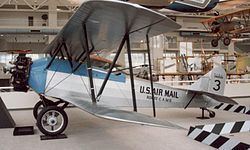Commenced operations April 6, 1926 Founded 6 April 1926 Date of operation 6 April 1926 | Ceased operations May 1934 | |
 | ||
Varney Air Lines was an airline company that started service on April 6, 1926, as an air-mail carrier. Formed by Walter Varney, the airline was based in Boise, Idaho, United States. The airline is the predecessor of United Airlines.
Contents
Historical background
In 1925, the Congress passed HR 7064 entitled "An Act to encourage commercial aviation and to authorize the Postmaster General to contract for Air Mail Service" (aka "The Kelly Act") which directed the U.S. Post Office Department to contract with private airlines to carry the mail over designated routes many of which connected with the Government operated Transcontinental Air Mail route between New York and San Francisco. Varney won the contract for CAM-5 as the only bidder. Boise Postmaster L.W. Thrailkill had the vision that brought the city into the aerial age. He heard about the proposed northwest route and Varney’s plan and quickly drew up a petition and got signatures from three dozen postmasters from the towns surrounding Boise. Its first flight under contract with the USPOD was from Pasco, Washington to Elko, Nevada with an intermediate stop in Boise. That air freight contract grew into the birth of one of the world’s biggest airlines.
Pasco at the time was a rail center, more or less midway between Portland, Seattle, and Spokane. Mail trains leaving those cities in the evening arrived in Pasco early the next morning. Mail could be transferred to and from the biplanes cutting coast to coast delivery by days. This was the logic for basing the CAM service in Pasco.
First flight
Pilot Leon D. Cuddeback flew the first eastbound CAM-5 flight, leaving in the early dawn hours from Pasco, Washington. Between 4,000 and 6,000 cheering people sent the pilot off with 207 pounds (94 kg) of mail. Cuddeback flew a Curtiss powered Laird Swallow biplane with a top speed of 90 miles per hour (140 km/h).
The first westbound flight that afternoon was much less successful, however, as it was forced 75-miles off course by a storm en route from Elko, Nevada, to Boise, Idaho, before making a forced landing near Jordan Valley, Oregon. The mail plane and its pilot, Franklin Rose, remained missing for two days until pilot Rose finally managed to reach a telephone on April 8 after carrying the 98 pounds (44 kg) of mail for many miles out of the wilderness by foot and later on a horse borrowed from a farmer. The westbound flown mail finally arrived at the post office in Pasco late on the morning of April 9, three days after leaving Elko.
Later history
Varney added a Breese-Wilde Model 5 and replaced its original Swallows with C-3 Stearmans and thereafter upgraded as new equipment became available. Subsequent aircraft included the larger M-2 "Bull" Stearman and the Boeing 40 dedicated mail planes, and finally the more modern Boeing 247 twin-engine monoplane. Arriving in 1933, the 247 greatly expanded Varney's ability to carry passengers as well as mail.
Varney soon added Salt Lake City, Portland and Seattle to its route. In 1930, it was acquired by United Aircraft and Transport Corporation (a Boeing-Pratt & Whitney Aircraft merger) and folded into its airlines group including Pacific Air Transport, Boeing Air Transport, and National Air Transport which were later spun off, in May 1934, to form United Airlines. United Airlines started jet service to Boise on October 16, 1964, and is the only airline to serve Boise continuously since 1933. With the Beeson terminal remodeling at the airport, the last Varney building was torn down in 2002.
